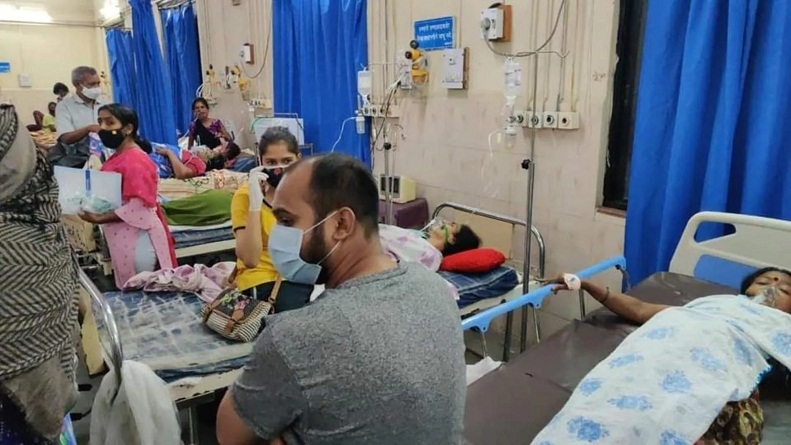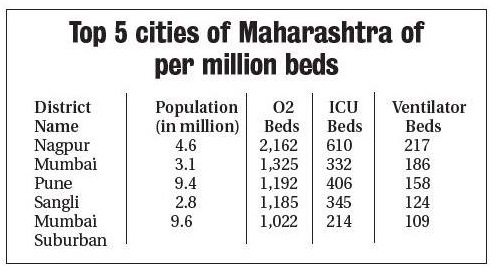Nagpur has more beds per million population than Mumbai, Pune
| Date :13-May-2021 |

■ Staff Reporter :
■ Pips capital city and Pune in strengthening health infrastructure in terms of number of beds in oxygenated, ICU and ventilator, reveals Govt data
AS SECOND wave of COVID-19 put great strain on the resources as the scale of infection and patients was far greater than what system was prepared for, still Nagpur chartered its course from the choppy water and emerged on top in ramming-up health machinery in Maharashtra. This is a proud moment for Team Nagpur, comprising the political leadership who worked shoulder to shoulder cutting across party lines and the administrative machinery on ground that is running the show 24x7 without a break. Nagpur has emerged as the fastest to scale-up its health infrastructure in Maharashtra in the testing times of pandemic. This is revealed by statistics collated by Maharashtra Government and released recently. Today, Nagpur has highest number of oxygenated beds, ICU beds, ventilator beds per million population in State.

The health facility in city caters to vast rural population of Vidarbha and also to populace of neighbouring districts of Madhya Pradesh and Chhattisgarh States who know for advance treatment and in emergency, one has to hop onto second capital of Maharashtra. The combined might of Union Minister Nitin Gadkari, Guardian Minister Dr Nitin Raut, Leader of Opposition Devendra Fadnavis and Mayor Dayashankar Tiwari along with civic and district administration worked round the clock for one month and the results are now for all to see.
A list compiled by State Government showcase that Nagpur is ahead of metropolis Mumbai and second biggest city of State, Pune, in terms of total beds, especially oxygenated and ICU plus those with facility of ventilator in terms of per million population Inspite of huge strain on resources and system and the hurdles due to strict curbs, the administration at Nagpur Municipal Corporation (NMC) and District Collectorate operated a synchronised operations to put in place required health care system for citizens who were harried a lot due to shortages of everything, beds, oxygen to medicines. Especially the month of April was worst from Nagpur district this year, as was September during the first wave, and the situation spiralled out of control as panic gripped citizens as viral load increased very fast. From March end as the cases started peaking, within few days they hit a new high in April, and scramble began for oxygen, oxygenated beds, ICU system, ventilators. COVID-19 positive patients were coming in with complaints of trouble with breathing as in second wave, people had issues of breathlessness.
As later emerged that double mutant strain of COVID-19 had played the role in faster spread of the virus among citizens in region and they found it hard to access the already stressed health system. But puling-up socks and keeping cool heads, the city leaders put together the resources, pulled out all stops and machinery responded with faster clearances, roping in NGOs to ramp up the health infrastructure. The emphasis was laid on strengthening the health system while planning for further improving health services so that in future if such emergency occurs then citizens should not suffer. As a result now Nagpur has overtaken Mumbai and Pune in strengthening the health system. With a population of one million, the number of all types of beds is higher than any other city in the state, reveals a comparative analysis of the compilation done by Maharashtra Government, said Jalaj Sharma, Additional Municipal Commissioner, NMC, who analysed the data.
Nagpur district has a population of 46 lakhs of which urban population is around 23 lakhs. Besides people form rural areas of district and those from cities bordering Madhya Pradesh and Chhattisgarh are availing health services in city. After the first wave of corona subsided, a second wave started in late March and by April even as mercury was steadily rising, so did the COVID19 patients. The stress on the health system increased tremendously during this period as the mismatch in availability and requirement revealed several shortcomings. But working systematically every sector was given due attention with focus on ironing out issues and improvement occurred thereafter. At the beginning of April, civic and the district administration imposed some restrictions as people were crowding in markets and big gathering and it was contributing to high viral load.
In the second week after that, the State Government announced strict restrictions that helped a b it in breaking the transmission chain. During this period, efforts were made by Corporation officials and the Revenue administration to strengthen the health system in the city. Mayor along with Radhakrishnan B, Municipal Commissioner; and Ravindra Thakare, District Collector, set out action plan for setting up oxygen plant at the hospital. Along side efforts were put in to increase the number of beds. Political leadership also rose to the occasion and ensured that oxygen whose demand was rising fast was met with. Oxygen tankers were pressed in to bring in the liquid medical oxygen from far off places like Angul in Orissa, from Bhilai Steel Plant, and other places. Ventilator that was in short supply were procured and supplied to hospitals along with other required medical equipment. As a result now Nagpur district currently has the highest number of beds per ten lakh population in the State as compared to other districts. During first wave, there was only 66 Dedicated Covid Hospital and now their number has increased to 88 at end of March and further increased to 108 in April and now about 146 hospitals are granted permission by NMC to treat COVID-19 patients, said Sharma. However the chart of State indicates that in terms of per million beds, Nagpur ranks in fifth position.
No shortage of beds, medicines WITH waning of COVID-19 infection rate, now the health machinery is much better placed to serve the citizens as there is no shortage of beds, medicines in district. The district on Wednesday received 110 Metric Tonnes of oxygen from various sources and nowhere any hospital reported any additional requirement. Further, the supply of Remdesivir injection has also stabilised and gradually its demand is decreasing day by day as hospitals are now not much in hurry to lift the allotted stock. Only after assessing the situation and demand the injections are being ordered as now new guidelines on its use has come into force. Similarly availability of beds continue to improve with oxygenated beds at Dedicated Covid Hospitals (DCHs) and isolation centres now stands at 1942 in total while 319 ICU and 10 ventilators beds were also avail